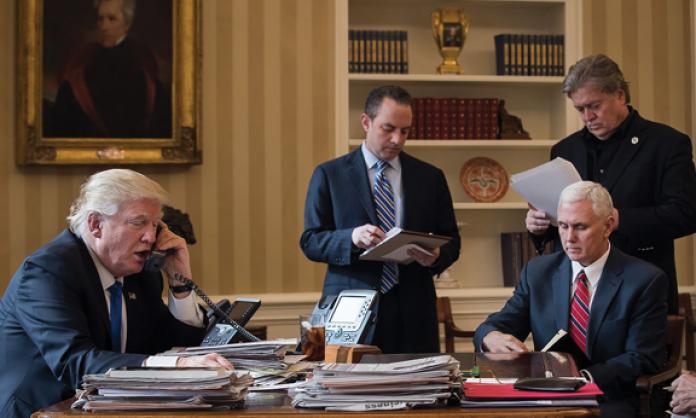When I spoke with Joel Geier a week or so after Donald Trump’s inauguration, he told me, “It’s a 1950s McCarthyite administration meeting a 1960s protest movement in open combat. Every day is extraordinary, totally unexpected chaos – politics exploding in unimaginable ways”.
This was the time of the massive Women’s March on Washington, of the attempt by the Trump White House to govern by decree, with an endless stream of Executive Orders mandating everything from the construction of a border wall to the infamous Muslim ban that drew thousands of protesters to airports around the country.
It was the period in which everyone – from the socialist left and Black Lives Matter activists to the CIA, the State Department, the Washington Post and Democratic politicians – seemed to be part of the “resistance”.
And it was the time where alt-right radicals in the administration, most notably former Breitbart editor Steve Bannon, were declaring their determination to “dismantle the administrative state” and rip apart the institutions of permanent government that Trump supporters decried as the “deep state”.
When I spoke to Geier two months later, I asked what had changed. “Those first couple of months, the administration was a train wreck, falling apart”, he said. The extreme right Bannon-Breitbart group around the president was determined to change everything at once. “They declared war on the press, on the courts, on the administrative state, the deep state, the CIA, China, Mexico, Germany, Australia – everyone.”
But a rapidly escalating series of setbacks for the administration – from the failure of the Muslim ban to the intelligence leaks that brought down national security advisor Michael Flynn, and the growing scandal about Trump’s alleged Russia ties that threatened a “Watergate moment” – had a profound impact. It became clear that “if it was Breitbart vs. the deep state, the deep state would win”.
This doesn’t mean that the economic nationalist “America first” agenda on which Trump swept to office has been ditched. Instead, there has been a change in strategy. “Their idea was to get rid of all of the centres of power so they could carry out their political program. Well, that failed. If they want to carry out their political program they have to do it through these centres of power. And they have started to do that”, Geier said.
The cruise missile attack on Bashar al-Assad’s Shayrat airbase in Syria on 6 April, a trivial exercise in military terms, was a political shift. In the eyes of the liberal press and the political establishment, Trump “was no longer Putin’s puppet, he was no longer a neo-fascist, but the leader of the free world, embraced by all”. Normality had returned “because America bombed something”. This, Geier said, was “an enormous change in the ruling class party line”.
What did the Syria strike mean for the internal battle in the White House, which, according to the New York Times is a power struggle between Steve Bannon and Trump’s son in-law Jared Kushner and his Wall Street allies?
“The ruling class and the media would like to see Steve Bannon marginalised. There is a tremendous press campaign to say that and to say the Goldman Sachs/Kushner wing has won out. I would not necessarily come to that conclusion yet. The frontal assault of economic nationalism that the Bannon wing represents has been called off, but that doesn’t mean the struggle is over at all. Their economic nationalist agenda is still the main ideological conception of the Trump White House.”
CONFRONTING THE RISE OF CHINA
The crux of this agenda is restoring American industrial and military power, particularly in relation to China. “Whether Bannon goes or not, that is not going to change. What has changed is they were going in a kamikaze way for those policies, and that is what has blown up.”
The core agenda of the Trump administration has a rational basis from the point of view of US capitalism. It is an attempt to respond to the undermining of US global hegemony, the rise of China as an unprecedented threat to US imperial power and the failure of existing US policies to deal with this situation.
American imperialism has been declining, not just in the Middle East but throughout the world. Economically, there has been an enormous shift in the past 15 years. China is becoming an economic force in Latin America, Asia and Africa. The Chinese economy expanded from a GDP of US$1 trillion in 2001 to US$11 trillion in 2016. By contrast, the US economy was battered in the 2008 crisis and has been slow to recover. But the problems are not simply about relative rates of economic growth:
“The United States cannot be the leading imperialist power on the basis of a service economy. It came to be the dominant imperialist power in World War Two by being the ‘arsenal of democracy’; by being the industrial backbone of the entire allied war effort. The Russians fought more, but it was American industry that won the war against Germany. Now the US is dependent on China for its computers, iPhones and instrument panels for its military planes”.
The rise of China, Geier said, is also “going to open up a new phase of imperialism”. Chinese military spending is expected to double in the next decade, and the government is asserting itself more aggressively in the region, particularly the South China Sea. “For the first time since World War Two, the US has a serious economic imperialist rival that is also a military rival.”
The economic and military challenges combine to create an existential crisis for the US as a global hegemon. “Either they deal with this or they go the way of Britain.” Dealing with it though, will not be easy.
The US ruling class faces not only a rising power, but a state-directed competitor. Geier described the Chinese system as “the kind of capitalism that developed during World War One, in which the state makes all important economic and military decisions. The US is up against that. And it has no discipline. Now you have this peculiar messenger, Trump, who hasn’t got any discipline over himself and he’s supposed to establish discipline over the capitalist class!”
A central factor making the imposition of any discipline difficult is the huge divisions in the US ruling class over what attitude to take toward China, which flow from the contradictory interests of different US corporations. For example, Walmart gets its cheap goods from China. And while Apple is the biggest corporation in the US, China is both the sweatshop for the production of its goods, as well as its biggest market. General Motors now produces and sells more cars in China than it does in the United States.
And it is not just a matter of dealing with the sectional interests of corporations such Walmart and Apple. “The conservative, politically illiterate American capitalist class has the delusion of having a small government and low taxes – and being the biggest imperial power in the world. It is a totally utopian way in which to deal with American power.” This means that a serious attempt to implement Trump’s economic and foreign policy, and contain China’s rise, will “require an enormous fight within the American ruling class”.
Nonetheless, Trump does possess a clear program for how the situation could be turned around: “Deregulation, cutting corporate taxes, cheap energy, cutting social benefits, and through anti-union legislation to hold down wages and keep the US as the low-waged section of the advanced industrial world”. All these policies are aimed at maximising corporate profits and restoring US manufacturing. Trump also says he will carry out infrastructure projects that will be a boon to capital. And he wants to introduce taxes on imports and concessions for exports.
Trump believes that an economic nationalist program for capital can be given a popular base by offering various verbal concessions to workers. “Trump says there will be jobs, even though that’s a pile of bullshit. This is the most reactionary anti-working class regime since before the Depression the 1930s. But it’s presented as if this is a populist program.”
TRUMP IS TAMING THE ‘INSTITUTIONS’
Large sections of capital are still distrustful and apprehensive of Trump’s approach. “Even if they would be happy with this further transfer of wealth from labour to capital they are nervous – afraid of a more genuine left populist revolt à la Bernie Sanders and fearful that the system will be destabilised”, Geier said.
Yet the intense hostility has receded. Capital has been mollified by Trump abandoning his assault on the apparatuses of power – abandoning “crackpot ideas” like cutting the State Department by a third, or letting Steve Bannon run the National Security Council. They will support him on Korea in what is a surrogate war with China and will reconcile themselves to certain aspects of American protectionism. Trump has also consolidated support in other important institutions of the state and the right:
“Trump has the support of the religious fundamentalists. He’s given them Neil Gorsuch on the Supreme Court, and Betsy DeVos is in charge of education. He has the support of the racists. He has given them attorney general Jeff Sessions, [political advisor] Stephen Miller and worst of all John Kelly, the head of Homeland Security, who has criminalised all undocumented immigrants as ‘illegal aliens’ and is rounding them up Gestapo-style on the streets and deporting people without any legal procedures.
“He has the support of the military – of the Pentagon. They are now in charge of defence and national security. It is no longer the crackpots – it is the main military, people like defense secretary James Mattis. And Trump has the support of Wall Street, of Goldman Sachs, which hopes that profits are going to be flush as a result of deregulation and cuts on corporate tax. Trump’s White House is now taking over the ‘administrative state’. This is the ‘march through the institutions’ of the right wing.”
They have become a right wing version of “Nicos Poulantzas types” – a reference to the Greek-French sociologist who championed the idea radicals could seize the existing state apparatus and use it to achieve their ends. Many have championed these institutions as the last line of defence against Trump. But the longer the Trump administration goes on, the more it becomes clear that the greatest danger is not a president Trump at war with the institutions of US imperialism, but a president Trump at one with them.











